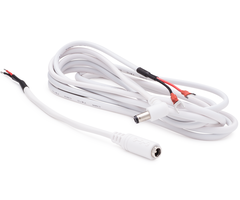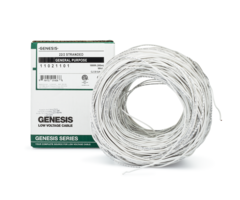What Are The Wiring Recommendations For an Alarm system?
The recommended wiring for alarm systems is 18-gauge to 22-gauge, also called AWG. Use 18 AWG, 2-conductor for transformer wiring, and 4-conductor for wired keypads. 22-AWG is recommended for zone wiring. Use a 4-conductor for powered devices, or a 2-conductor for wiring non-powered devices.

Alarm wire is measured by its diameter, and the diameter is expressed by a gauge number. Here, we use the AWG or American Wire Gauge to represent wire size. The thinner the wire, the higher the AWG number. 16 AWG is much thicker than 22 AWG. Generally, for power applications, a thicker wire is recommended, and for non-powered applications a thinner wire is acceptable.
Alarm wire comes in many sizes. You typically see anything from 16-gauge to 22-gauge being used. We recommend using 18-gauge wire for most applications. Some applications list 18-gauge as the largest acceptable wire to use. It is for this reason that we recommend it for DIY users. The use of 18 AWG will be fine for applications that usually require a smaller wire, but 22 AWG may NOT be suitable for something like a transformer wire run. By standardizing on 18-gauge, a DIY user won't have to purchase boxes of wire in multiple sizes. In many instances, though, the size of the wire is not the most important aspect. It all depends on what you will be passing through the wire and the distance you need to run it.
Wire also comes with a different number of conductors in each wire. Two (2) and four (4) conductors are the most popular. All of the above-mentioned wires can be found in both solid core or stranded wire. For alarm systems, we strongly recommend using stranded wire. Solid core wire can only tolerate so much moving and bending before it will snap. Stranded wire is much more forgiving.
Another wire variation is shielded vs unshielded. For alarm systems, we recommend unshielded wire for almost all applications. As a general rule, the use of shielded wire in alarm applications will decrease the maximum distance you can run a wire, and at times, increase the likelihood of introducing interference. There are exceptions to this rule, but they are rare. You may notice all of the alarm wire Alarm Grid sells is unshielded.
For alarm systems, you will be passing AC voltage and current, DC voltage and current, or you may only be concerned with resistance. Many hardwired systems use an AC transformer to power the system. Most newer All-In-One systems use a DC Power Adapter. It is very important not to mix the two up, as doing so could damage your alarm system. AC voltage and current can travel a longer distance than DC voltage and current when passing through the same gauge wire. This is why the wiring specifications for power are so important on the newer systems that use a DC Power Adapter instead of an AC transformer.
When using an AC transformer, wiring distance is usually less of a concern. AC power loss through a good cable is minimal. 16 -18-gauge is recommended for most installs, and the power wiring should be kept as short as possible. Refer to your installation guide for specifics. We've included a few specs that we have found.
AC Wire Requirements
This table breaks down the maximum AC wiring allowances for multiple panels.
| PANEL | MAX GUAGE | DISTANCE |
|---|---|---|
| VISTA Non-Fire Panels | 16 | 250' |
| Concord 4 | 16 | 25' |
| Napco | 18 | 15' |
When using a DC transformer, as opposed to an AC one, power loss through the wire is of much greater concern. All-In-One panels will always have a specification regarding the wire gauge used and the maximum distance you can run the wire, based on your chosen gauge. This information will always be in the installation guide. For examples, see the chart below.
DC Wire Requirements
This table breaks down the maximum DC wiring requirements for multiple panels.
| PANEL | MAX GUAGE | DISTANCE |
|---|---|---|
| L5200 | 18 | 26' |
| L5210 | 18 | 26' |
| L7000 | 18 | 26' |
| Lyric | 18 | 20' |
| PROA7PLUS | 16 | 120' |
| 2GIG Edge | 18 | 125' |
| IQ Panel 2+ | 18 | 25' |
| IQ Panel 4 | 18 | 98.5' |
| IQ4 Hub | 18 | 98.5' |
For all of our alarm panel kits that require a separate power wire, we include the Honeywell LT-CABLE. This is a 2 part cable. The first part is an 8-foot long, 2-conductor, 18-gauge wire. It has spade terminals on one end and a male quick-connect barrel-style connector on the other. The second part of this is a 7" dongle with a female quick-connect on one end and pre-stripped flying leads (loose wire) on the other end.
The spade terminals are ideal for connecting to the plug in transformers that power alarm systems. The barrel connector can connect directly to some panels, and for those panels without a barrel connector, the pre-stripped leads connect to the panel's power terminals. The quick-connect is also a quick-disconnect, which can make powering the panel down and back up very easy. The wires are marked with Red and Black leads at both ends, perfect for use with DC-powered systems. For systems that use an AC transformer, either conductor can connect to either terminal.
When running wire for hardwired zones, your main concern is keeping the resistance low. Hardwired zones will always have a resistance tolerance. This is the amount of resistance, in addition to the end of line resistor (EOLR), that the zone allows before it will go from a normal (closed) state to a violated (open) state. Refer to your specific panel to see what the zone tolerances are. Because of this, zone wire can be run for long distances.
When you will be doing a lot of wiring, a box of wire that can cover most applications is preferred. Sometimes though, you may only need a short piece of wire to add to, or complete a job. For these applications, we also have 22-gauge, 4-conductor alarm wire available at shorter lengths. We carry it at 10', 15', and 25' lengths.
A good deal of zone wiring, for items such as doors and windows, can be run using a 2-conductor wire. You may, however, have two (2) windows, side-by-side where it makes sense to run a 4-conductor to the location and wire each window separately. Also, hardwired motions and glass break detectors require power in addition to their zone wiring. This is another prime application for 4-conductor wiring. Using two (2) wires for the zone and two (2) wires for the power is ideal.
Did you find this answer useful?
We offer alarm monitoring as low as $10 / month
Click Here to Learn MoreRelated Products











- Answered
- Answered By
- Fred Daniels


